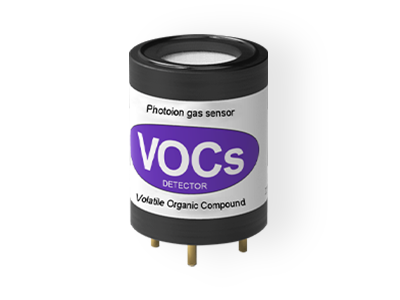This paper will explain what information a JXCT Volatile Organic Compound sensor can and cannot provide. The VOC sensor is as good as a CO2 sensor at indicating occupancy in a room and meets ASHRAE Standard 62.1. The VOC sensor has the added benefit of recognizing other air contaminants that affect human comfort and health so that they can be ventilated away as well.

Capabilities
VOC sensors informed ventilation system can optimize indoor air quality while minimizing energy use. There are over 5,000 VOCs that are expelled by breathing, cooking, bodily functions, perfumes, deodorants, paint, cleaners, cigarettes, office supplies, etc. JXCT’s VOC sensors monitor these gases and provides a CO2 equivalent ppm (parts per million) output which is then input to a DCV system.
The VOC sensor eliminates the need for frequent manual calibration by providing a relative measurement and using an Automatic Baseline Correction (ABC) logic algorithm. With ABC self-correction, the sensor constantly adjusts the 450 ppm baseline (outside air) to eliminate any sensor drift. The logic drives the sensor to quickly reduce the baseline when a time of low measurement is sensed.
VOC sensors directly measure ambient concentrations of a broad range of “reducing gases” associated with bad air quality. Examples are: alcohols, aldehydes, ketones, organic acids, amines, organic chloramines, aliphatic and aromatic hydrocarbons. These gases all burn and cause the sensor ppm output to increase. Opposite examples are sulfuric acid, nitric acid and ozone. These three are “oxidizing gases” (rather than “reducing gases”) and will NOT cause the sensor ppm output to increase. OSHA has set an exposure limit for sulfuric acid of 1 mg/m3 TWA (time weighted average); however, a JXCT VOC sensor is not the appropriate tool to monitor sulfuric acid or any other “oxidizing gases”.
Limitations
Because of the relative nature of the sensor output, the VOC sensor cannot define an accuracy tolerance. By definition, accuracy is the variation from an absolute measurement. Since the gas sensor uses ABC logic, there is no absolute measurement.
The VOC sensor is not an analytical instrument and should not be used in a safety application. It is a broad range sensor that cannot break out measurements of individual gases. For example, OSHA has set permissible exposure limits for ethyl alcohol. The VOC sensor will show elevated levels when ethyl alcohol is present and signal the HVAC system to increase ventilation, but the sensor cannot provide a specific ppm measurement of ethyl alcohol so that the user can document compliance to OSHA exposure limits.
The VOC sensor was designed to monitor common indoor air quality contaminants only. There are several gases that will affect the sensor reading but are not typical indoor contaminants. Typical outdoor gases such as SO2, H2, and CO will affect the sensor but have not been tested. The VOC sensor should not be used to monitor CO as it is not sensitive enough to meet safety and OSHA requirements.
The JXCT VOC sensor provides a CO2 equivalent ppm output so that Ashrae’s popular CO2-based VRP procedure can be used for DCV; however, CO2 is not one of the VOCs that the sensor monitors. If your application needs to directly measure CO2, choose a CO2 sensor.
 : +86 155 8830 2704
: +86 155 8830 2704 : jxdziot@gmail.com
: jxdziot@gmail.com
